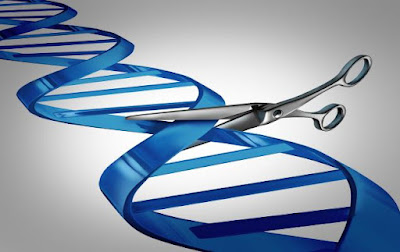By: Ranier Simons, ADAP Blog Guest Contributor
Scientific innovation in the fight against HIV created the current landscape of antiviral treatment, which allows people living with HIV (PLWH) to manage chronic viral infection and lead long, healthy lives. Recent medical advancements give a glimmer of hope for advanced viral suppression and the potential for a future cure. A recent University of Amsterdam laboratory study using CRISPR-Cas9 gene editing technology was able to eliminate HIV from infected cells in a controlled environment outside of the body.[1,2] This development is proof of concept, which could mean eradicating HIV from the bodies of PLWH will be achievable one day.
 |
| Photo Source: YouTube | SciTech Alerts |
CRISPR stands for ‘clustered regularly interspaced short palindromic repeats.’[3] It is technology based on how bacteria naturally use gene editing systems to protect themselves from viral infection. CRISPR-Cas is a system. Cas is an enzyme, and Cas9 is an enzyme that specifically can cleave DNA. CRISPR is a sequence of RNA. In simple terms, the CRISPR-Cas9 complex is effectively a ‘seek and destroy’ pair of molecular scissors that can search for and cut out undesirable genetic material.[4]
When the HIV invades the body and infects cells, it integrates its genetic material into the host cell’s genome. Current antiviral medications help to prevent the virus from replicating in the body. However, ART does not attack the dormant virus that lies in wait in viral reservoirs. This is why lifelong ART is necessary since HIV infection can rebound from these reservoirs if medication is discontinued. Dr. Elena Herrera-Carrillo and her team at the University of Amsterdam recently used CRISPR-Cas9 technology to completely eliminate the HIV virus from cell cultures.[5]
The team focused on a specific part of the HIV viral genome that seems to be present in all known HIV strains. Testing with infected CD4+ T-cells, the team modified their CRISPR-Cas9 complex to inactivate and excise the targeted HIV viral DNA. Thus, HIV was eliminated entirely from the cells since the genetic code necessary to form it was removed, effectively destroying HIV’s building blueprint. Additionally, they were able to target what they described as hidden reservoir cells by identifying specific proteins present on their cell surfaces.[5]
 |
| Photo Source: Newsmax |
This study is promising, but by no means is an immediate cure for HIV. The experiment was a very specified cell culture exercise outside of the body. HIV can infect many kinds of cells and tissues of the body with varying characteristics and environments. Future research needs to investigate how to target HIV in all those circumstances and conditions.[5] Also, HIV reservoirs have long half-lives and can be found in many different cells and tissues, such as the central nervous system and the male urogenital tract.[6] To effectively eradicate HIV from the body would require eliminating HIV from every infected cell and every latent reservoir. No proverbial stone could be left unturned since even the smallest one percent of a reservoir could potentially reactivate and spawn HIV replication.
Gene editing can also have unintended consequences.[7] When genes are cut with CRISPR technology, the process by which cells heal the excisions and reform introduces errors into the genome. Without precise targeted CRISPR techniques, gene sequences can be edited and rewritten in ways that cause mutations, resulting in cancer promotion or other unwanted biological process alterations. The human body is a very complex system of systems. Developing a CRISPR cure for HIV would require foolproof ways to enter appropriate cells while avoiding others, in addition to ways to mitigate dangerous side effects.
While a CRISPR cure for HIV is nowhere near to becoming a reality, the Amsterdam study is a source of hope and a guide for the future. Innovation is incremental. This study will be a steppingstone and guidepost for other scientists to build upon and spawn future breakthroughs. Dr Carrillo states, “We hope to achieve the right balance between efficacy and safety of this CURE strategy…Our aim is to develop a robust and safe combinatorial CRISPR-Cas regimen, striving for an inclusive ‘HIV cure for all’ that can inactivate diverse HIV strains across various cellular contexts.”[1] While we will not see human clinical trials until the science reaches this point, at least we have a newly developing tool to add to the HIV antiretroviral arsenal.
[1] Good News Network. (2024, March 23). Scientists discover potential HIV cure that eliminates disease from cells using CRISPR-Cas gene editing. Retrieved from https://www.goodnewsnetwork.org/scientists-discover-potential-hiv-cure-that-eliminates-disease-from-cells-using-crispr-cas-gene-editing/
[2] Wilson, C. (2024, March 19). CRISPR could disable and cure HIV, suggests promising lab experiment. Retrieved from https://www.msn.com/en-us/health/other/crispr-could-disable-and-cure-hiv-suggests-promising-lab-experiment/ar-BB1kbDkU
[3] National Institutes of Health. (2024, March 27). CRISPR. Retrieved from https://www.genome.gov/genetics-glossary/CRISPR#:~:text=CRISPR%20(short%20for%20%E2%80%9Cclustered%20regularly,editing%20systems%20found%20in%20bacteria.
[4] Hussein, M., Molina, M. A., Berkhout, B., & Herrera-Carrillo, E. (2023). A CRISPR-Cas Cure for HIV/AIDS. International journal of molecular sciences, 24(2), 1563. https://doi.org/10.3390/ijms24021563
[5] American Association for the Advancement of Science. (2024, March 19). HIV in cell culture can be completely eliminated using CRISPR-Cas gene editing technology, increasing hopes of cure. Retrieved from https://www.eurekalert.org/news-releases/1038161
[6] Pierson, T., McArthur, J., & Siliciano, R. F. (2000). Reservoirs for HIV-1: mechanisms for viral persistence in the presence of antiviral immune responses and antiretroviral therapy. Annual review of immunology, 18, 665–708. https://doi.org/10.1146/annurev.immunol.18.1.665
[7] Hunt, J. M. T., Samson, C. A., Rand, A. D., & Sheppard, H. M. (2023). Unintended CRISPR-Cas9 editing outcomes: a review of the detection and prevalence of structural variants generated by gene-editing in human cells. Human genetics, 142(6), 705–720. https://doi.org/10.1007/s00439-023-02561-1
Disclaimer: Guest blogs do not necessarily reflect the views of the ADAP Advocacy Association, but rather they provide a neutral platform whereby the author serves to promote open, honest discussion about public health-related issues and updates.
No comments:
Post a Comment